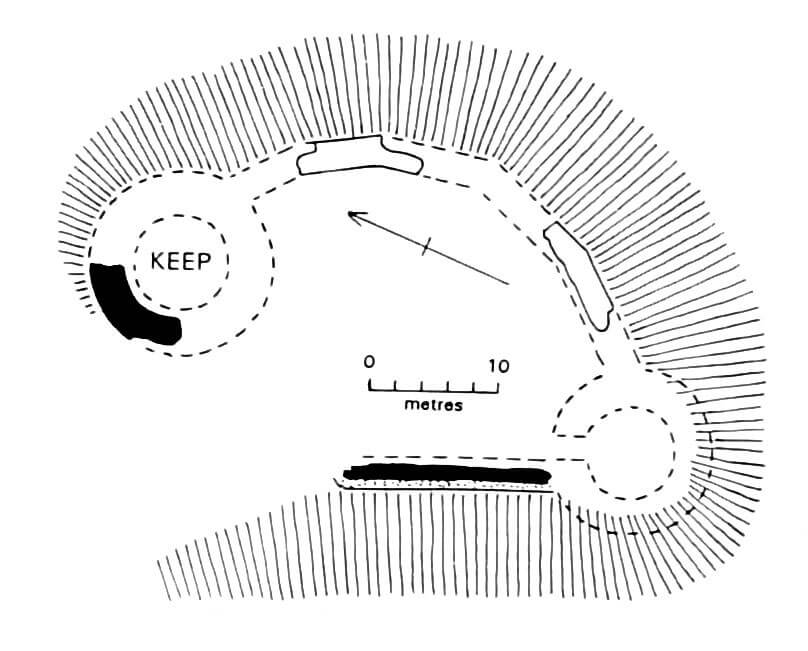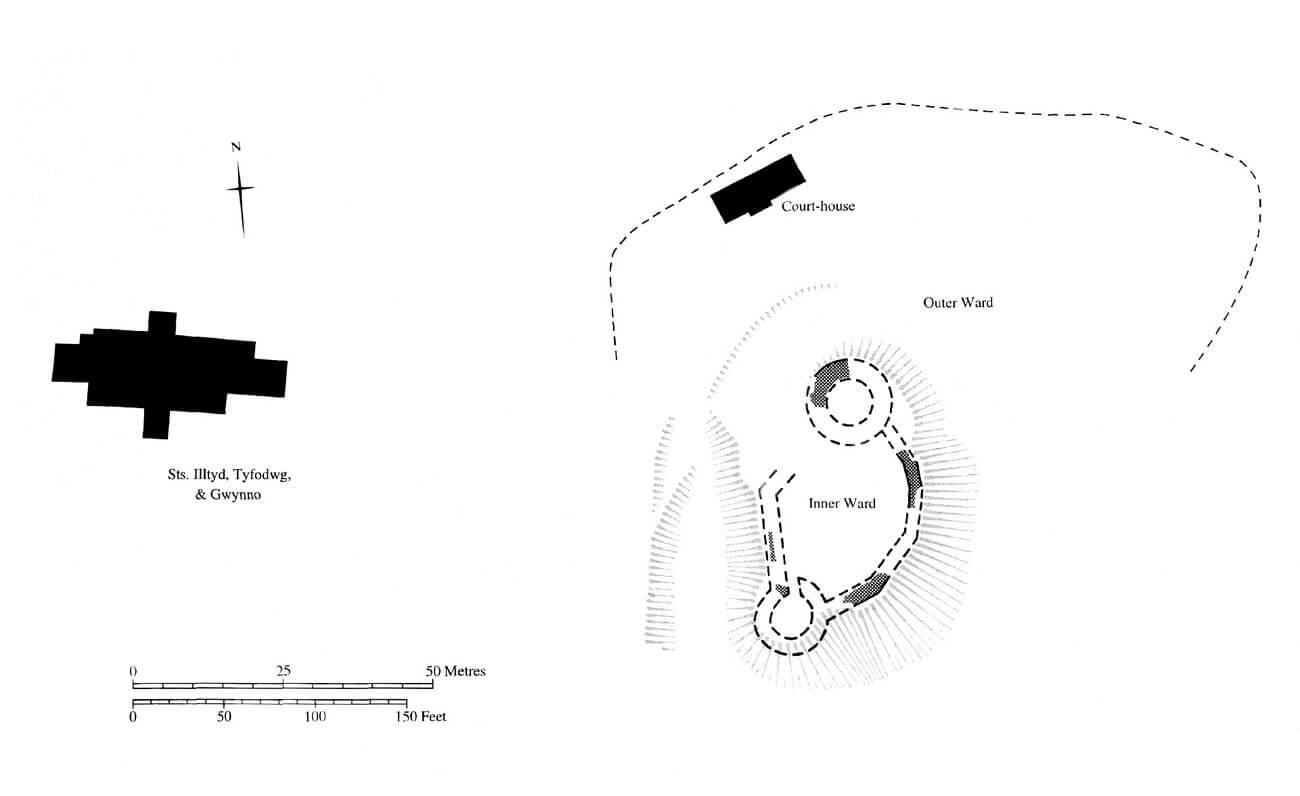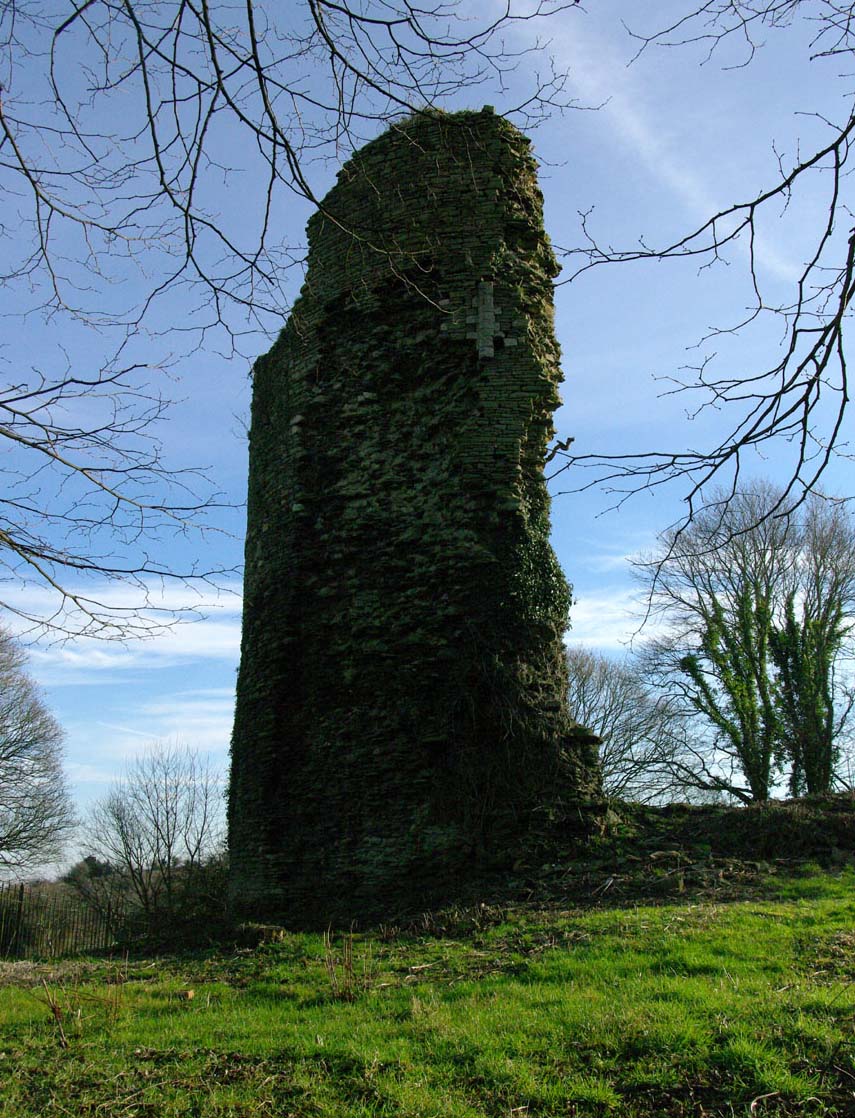History
The castle was erected in the mid-13th century by Richard de Clare, Earl of Gloucester, Lord of Glamorgan, to guard the newly conquered lands and the important route from the mountainous regions to the lowlands of Wales. Its construction probably took place in the years 1246-1252, after de Clare deprived the local ruler of the Meisgyn region, Hywell ap Maredudd, and it could have been erected on the site of older timber and earth fortifications from the 12th century. The construction of the castle was related to the events of 1244, when Hywel ap Maredudd and Richard Siward from Llanblethian and Talyfan Castle first started conflict despite a truce arranged by the Earl, and then in 1245 allied against Richard de Clare. After taking the lands of the opponents, Llantrisant seemed an ideal place for an earl to secure communication routes. The completion of construction was related with the date 1252, because then it was recorded that the earl’s daughter was born in Llantrisant.
In 1262, the castle passed into the hands of the lord Gilbert II de Clare. He pacified the Welshmen in the highlands of Meisgyn, and in 1267 he entered the previously independent Senghennydd, where he founded the magnificent Caerphilly Castle. The Welsh resistance was suppressed until 1272, which allowed for the expansion or strengthening of the Llantrisant Castle and the restoration of the adjacent settlement, raised to the rank of a borough even before 1262.
In 1294, the uprising of Madog ap Llywelyn broke out, in Glamorgan led by the disinherited Morgan ap Maredudd. Llantrisant was captured and ravaged by the Welsh invasion, and the Earl Gilbert was saved only in 1295 by the intervention of royal forces. The damages were so great that in 1297 the reconstruction of the castle was not finished. It was then that the castle constable was instructed to complete the work on the gate. It is known that due to fear of further attacks during the reconstruction, the Anglo-Normans took hostages from Meisgyn and Glynrhondda, who that year petitioned the king with requests for release. However, the ruler did not allow them to be released before the aforementioned gate was completed. The rebuilding of the town and the castle was completed only at the beginning of the 14th century, during the tenure of Countess Joan.
In 1314, after the death of Gilbert de Clare, the eighth Earl of Gloucester, killed in the Battle at Bannockburn, the castle was attacked and damaged by the Welsh. As early as 1316, another Welsh uprising of Llywelyn Bren broke out, caused by the strict rule of Payn Turberville, appointed by the king to govern Glamorgan after the death of Gilbert de Clare. Llantrisant Castle was damaged again and its garrison was wiped out with the exception of the constable. The repairs required stone, lime mortar and sand as requested by the new keeper, William Fleming. Probably the damages were removed until Glamorgan was taken by a new lord in 1317, who was appointed by the king – his favorite, Hugh Despenser. His greed for power and wealth was met with hostility by Anglo-Norman barons, which led to the uprising of the Marcher Lords in 1321. Llantrisant was once again invaded, ravaged and robbed of all property. In 1326, Despenser was captured near the castle, and the unfortunate King Edward II was imprisoned, and then taken to Berkeley Castle, where he was murdered. Before the capture, he had already appointed Dafydd ap Meurig, Hywel Sais and Gruffydd ab Ieuan Tate as castle keepers.
After the end of the uprising, Llantrisant remained in the hands of the Despenser family. On the king’s order, it was repaired in 1377, when Thomas Despenser was a minor. Contrary to a common tradition, the castle probably was not destroyed during the Owain Glyndŵr uprising at the beginning of the 15th century. It is true that in 1424 the town received extensive privileges from Richard Beauchamp, Earl of Warwick, but the castle, like many other Welsh strongholds, lost its military importance because of the pacification of the Welshmen. The last recorded constable of the castle was Sir Robert Jones, in office from 1485 to 1532. From 1495, it was directly subordinate to the English ruler, because after the death of Jasper Tudor Glamorgan returned to the Crown. According to the chronicler John Leland, the castle was to be partially inhabited in 1538 (the Gigfran – Raven tower was in use), although the remaining parts of the building were already falling into ruin. In the middle of the 17th century, Humphrey Mathew leased some castle rooms, so they had to be fit for habitation. The castle was probably abandoned shortly afterwards. In the 19th century, the Marquess of Bute used Llantrisant stone for his extensive building projects around Cardiff, Caerphilly and Castell Coch castles.
Architecture
The castle was built on a small hill, situated in a depression between the two larger hills to the east and west. In the south, the slopes descended into a wide valley and on to the coastal lowlands, and to the north, into the undulating highlands of Wales. In the immediate vicinity of the castle, on its western side, there was a settlement with the church of the Three Saints: Illtyd, Gwynno and Dyfodwg.
The castle consisted of two cylindrical towers, reinforcing from the north and south the curved curtains of the defensive walls, about 2.4 meters thick (in some sections slightly thinner), which surrounded a small courtyard measuring about 30 by 25 meters. Presumably, on the north-west side there was a four-sided gatehouse, leading to the northern outer bailey with dimensions of about 44 x 106 meters, surrounded by a wall. The gate was preceded by a ditch, also made of an easily accessible half-sided side. It could, like the entire core of the castle, resemble the better-preserved Castell Coch.
The north tower was approximately halfway in front of the adjacent curtains. It was located in the most sensitive place of the castle, flanking the gate and providing protection from the gentle approach. For this reason, it was the most massive element of the castle, with a diameter of up to 14.2 meters and walls up to 3 meters thick (so it was one of the largest of round towers that were erected in South Wales, where the diameters ranged from 10 to 12 meters). Perhaps the north tower served as a keep. The relics of the portal indicate that it was possible to get from it to the wall-walk crowning the walls, and then probably to the first floor of the nearby gatehouse. The south tower was built at the end of a narrow headland. Its diameter was about 10-11 meters.
Current state
To this day, only a fragment of the north tower has survived, reaching 13 meters in height, the remains of three sections of the defensive wall with a maximum height of 4.8 meters (on the south-eastern side) and small, stone relics of the foundations of the south tower. Admission to their area is free.
bibliography:
Glamorgan later castles, Royal Commission on the Ancient and Historical Monuments of Wales, Llandudno 2000.
Salter M., The castles of Gwent, Glamorgan & Gower, Malvern 2002.



